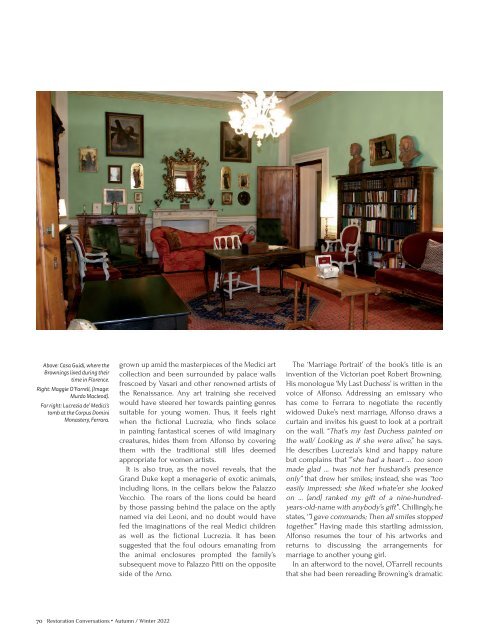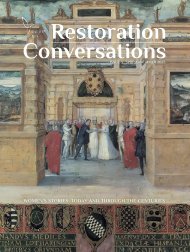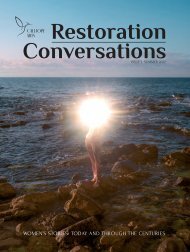Autumn/Winter 2022
Restoration Conversations is a digital magazine spotlighting the achievements of women in history and today. We produce two issues a year: Spring/Summer and Fall/Winter
Restoration Conversations is a digital magazine spotlighting the achievements of women in history and today. We produce two issues a year: Spring/Summer and Fall/Winter
You also want an ePaper? Increase the reach of your titles
YUMPU automatically turns print PDFs into web optimized ePapers that Google loves.
Above: Casa Guidi, where the<br />
Brownings lived during their<br />
time in Florence.<br />
Right: Maggie O’Farrell, (Image:<br />
Murdo Macleod).<br />
Far right: Lucrezia de’ Medici’s<br />
tomb at the Corpus Domini<br />
Monastery, Ferrara.<br />
grown up amid the masterpieces of the Medici art<br />
collection and been surrounded by palace walls<br />
frescoed by Vasari and other renowned artists of<br />
the Renaissance. Any art training she received<br />
would have steered her towards painting genres<br />
suitable for young women. Thus, it feels right<br />
when the fictional Lucrezia, who finds solace<br />
in painting fantastical scenes of wild imaginary<br />
creatures, hides them from Alfonso by covering<br />
them with the traditional still lifes deemed<br />
appropriate for women artists.<br />
It is also true, as the novel reveals, that the<br />
Grand Duke kept a menagerie of exotic animals,<br />
including lions, in the cellars below the Palazzo<br />
Vecchio. The roars of the lions could be heard<br />
by those passing behind the palace on the aptly<br />
named via dei Leoni, and no doubt would have<br />
fed the imaginations of the real Medici children<br />
as well as the fictional Lucrezia. It has been<br />
suggested that the foul odours emanating from<br />
the animal enclosures prompted the family’s<br />
subsequent move to Palazzo Pitti on the opposite<br />
side of the Arno.<br />
The ‘Marriage Portrait’ of the book’s title is an<br />
invention of the Victorian poet Robert Browning.<br />
His monologue ‘My Last Duchess’ is written in the<br />
voice of Alfonso. Addressing an emissary who<br />
has come to Ferrara to negotiate the recently<br />
widowed Duke’s next marriage, Alfonso draws a<br />
curtain and invites his guest to look at a portrait<br />
on the wall. “That’s my last Duchess painted on<br />
the wall/ Looking as if she were alive,” he says.<br />
He describes Lucrezia’s kind and happy nature<br />
but complains that ‘”she had a heart … too soon<br />
made glad … twas not her husband’s presence<br />
only” that drew her smiles; instead, she was “too<br />
easily impressed; she liked whate’er she looked<br />
on … [and] ranked my gift of a nine-hundredyears-old-name<br />
with anybody’s gift’”. Chillingly, he<br />
states, ‘”I gave commands; Then all smiles stopped<br />
together.’” Having made this startling admission,<br />
Alfonso resumes the tour of his artworks and<br />
returns to discussing the arrangements for<br />
marriage to another young girl.<br />
In an afterword to the novel, O’Farrell recounts<br />
that she had been rereading Browning’s dramatic<br />
70 Restoration Conversations • <strong>Autumn</strong> / <strong>Winter</strong> <strong>2022</strong>





